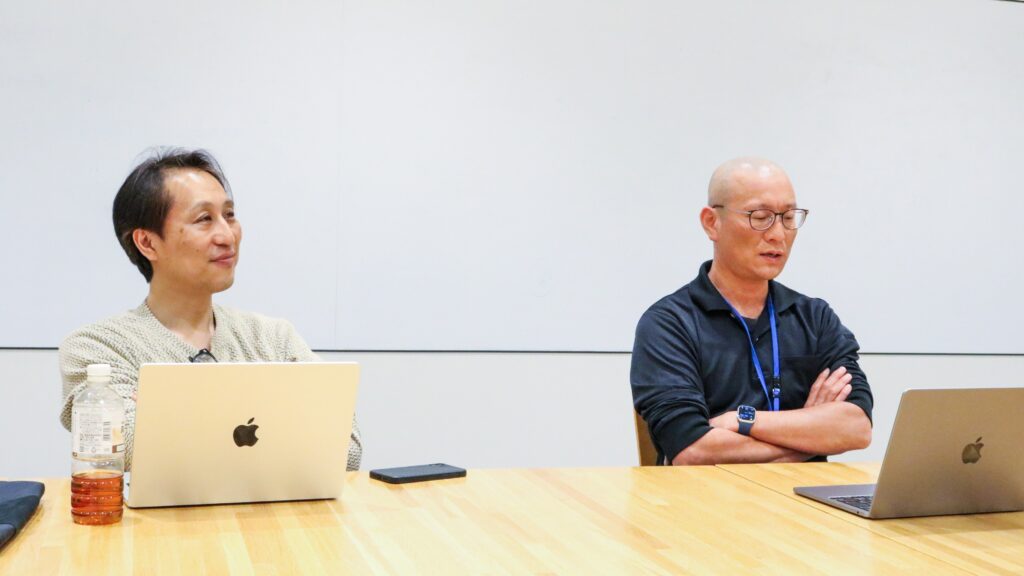2年かかっていた研究開発を数週間に。AIで構造タンパク質を高生産する条件を短期間で発見

2年かかっていた研究開発を数週間に。AIで構造タンパク質を高生産する条件を短期間で発見
構造タンパク質「Brewed Protein™素材」を開発、生産するバイオベンチャーであるSpiber株式会社。 Brewed Protein™繊維は、環境分解性を有することから、従来の動物由来、植物由来、合成素材に代わるソリューションを提供できる次世代の素材として期待が寄せられており、The North Face, Sacaiなど、16ブランドから71製品が販売されています。バイオテクノロジー部門の部門長である高橋 徹さまにEpistra Accelerate導入の背景やその後の変化についてお話を伺いました。
刻一刻とキャッシュアウトしていく中で、短い時間で成果を出す方法を徹底的に突き詰めたいと考えていた
ー まず高橋さんが統括する部門の役割について教えてください
バイオテクノロジー部門は、私たちSpiberが開発・製造しているタンパク質の原料をいかに安く、かつ高品質で作るかを、徹底的に技術開発する部門です。具体的にはタンパク質配列のデザインから、菌株育種、発酵生産プロセス、精製プロセス、スケールアップ、実機試作まで、微生物でタンパク質原料を作るすべての工程の研究開発を行っています。現在Spiberの社員は300名ほどで、そのうち40人のメンバーが在籍している、比較的規模の大きい部門です。

ー 最先端のバイオテクノロジー企業のエンジンのような部門ですね。Epistra Accelerateを導入する前に感じていた課題はどういったものでしたか?
さきほども話した通り、私たちの部門は、いかに安くかつ高品質なタンパク質素材を作れるかがテーマです。そのために、過去の知見を活かしつつ人海戦術でさまざまな条件を試し検討しています。しかし、一つのタンパク質の培養条件を決めるのに、おおよそ200回から300回ほどの条件検討が必要で、年単位の時間がかかっていました。
しかも使用目的に応じて、次々に新しいタンパク質を作る必要があります。そのため、一つのタンパク質だけに、長い時間をかけていられないという状況でもありました。
さらに、ベンチャーとして限られた資金を投資しながら研究開発をしていることもあって、一日一日が本当に貴重です。どうにかして実験回数を減らしたい、短い期間で成果をだす方法を徹底的に突き詰めたい、とずっと考えていました。

ー そもそもなぜそんなに多くの条件検討が必要になるのでしょうか?
(Epistra Accelerateの最初の導入事例である)培養条件の検討を例にお話しします。基本的には、微生物学という分野が昔からあるので、微生物が生育するための条件はある程度わかっています。例えば、pHであればここからこの範囲、温度であればここからこの範囲、というように。
なので我々がおこなうのは、すでに判明している条件に基づいて、pHなどのパラメータを一つずつ検討していく作業です。
ただ、そのパラメータは非常にたくさんあります。また、一つずつ検討した最高の条件を組み合わせても、最高の結果にならず、むしろ性能が下がることもあります。そのため、どうしても検討に多くの回数がかかってしまいます。
やはり生物としては、その他の外的環境が変わったとしても、自分自身が1番生活しやすいように生きていくものなので、人間が考えている以上に培養によるものづくりはうまくいかないものなんですね。

右:Spiber株式会社 Biotechnology部門 部門長 高橋徹 様
左:エピストラ株式会社 Ph.D. 共同創業者 CEO 小澤陽介
バイオプロセス開発へのAI導入の効果は半信半疑だったが、一度は試してみたいと思った
ーそのような差し迫った課題を抱えている中で、解決方法は模索していたのでしょうか?
はい。当時(2018〜2019年ごろ)、AI・機械学習という言葉をよく耳にしており、これはすごいものだという情報がひたすら入ってくるタイミングでもありました。バイオの分野に身を置いていても、ビックデータをAIに学習させて最適解を導くのが有効だと、さまざまな場所で見聞きしていました。
一方で、その技術が私たちの抱える課題に適用できるのかは、まだ疑心暗鬼の状態でした。また、課題解決に向けて、アカデミア・大企業との共同研究など、さまざまな試みを行っていた最中でもあったため、AIの活用に関してはあまり積極的には考えていませんでした
ーエピストラとの取り組みに踏み切るきっかけはなんだったのでしょうか?
エピストラの代表の小澤さんとたまたまお会いしたときに、AIを使った培養条件の最適化に興味がないかという話が出たのがきっかけです。詳しく聞いてみると、理化学研究所との共同研究で、iPS細胞の分化をテーマに、分化誘導条件の最適化にある程度成功しているという話でした。
バイオテクノロジーの分野ですでに一定の成果を出していて、Spiberにとっての非常に重要な課題である「短期間でのタンパク質の生産性向上」にもつながる可能性があるということで、半信半疑の状態ではあったのですが、期間を区切って試してみることにしました。
共通言語の存在とクオリティの高いサポートのおかげで、プロジェクトの初期から成果がでた
ー嬉しい驚きがあったのは何よりです。逆に、戸惑ったことはありましたか?
それは特にありませんでした。戸惑ったのは、むしろエピストラさんのほうだと僕は思っています。
というのも、AIを活用するうえでは、過去データを学習させることが最初の重要なステップです。ですが私達のデータは、人間が見ればわかるようにはなっていましたが、AIに学習させるような綺麗なフォーマットになっていませんでした。また、それなりに長い研究開発の期間の中で、記録している項目が変わったり、欠損値が含まれていたりなどの細かな課題もありました。
しかしエピストラさんは、課題をすり合わせていきながら、機械可読なフォーマットを作ったり、データの意味を確認したり、適切な欠損値の補完方法を考えたりしてくれました。おかげで、最初のところからスムーズに課題を解決できました。
私たちがつまずきそうなところを先回りしてフォローしてくれたので、私たちの戸惑いは少なかったです。
人には絶対に思いつかない条件をAIがだしてきたことで、人間の時代が終わると思った
ーEpistra Accelerateを導入した感想はいかがでしたか?
想像よりもはるかに早いタイミングで、成果が出たので驚きました。
過去データをAIに学習させて、10〜20回培養をしたところ、タンパク質生産量が大きく跳ね上がりました。その報告をはじめに聞いたときは、タンパク質量の定量評価が間違っているんじゃないかと疑って、定量評価のやり直しを指示したほどでした。
AIが考えた、生産性の高い培養条件にも驚きがありました。人間だと区切りのいい値を設定しがちですが、AIはそれよりもはるかに細かく値を設定していて、その小さな差の積み重ねが、結果的に大きな差を生んでいました。「こんなの人では絶対に思いつけない」と、ラボのメンバーは全員思ったのではないでしょうか。
短期間で、人間には絶対に思いつかない条件で高生産を達成する様を目の当たりにして、「特定の領域では人間の時代が終わるんだろうな」と実感しました。ベースの条件(探索の起点となる最初のうまくいく条件)は、これまでの経験もあるので、人間が作ってもよいかもしれません。しかし、そこから先の最適化は、もうAIに任せた方がうまくいくということがよくわかりました。
研究者としては寂しい思いもありますが、企業の研究開発の責任者としては、確かな技術を選び取って積極的に導入し、事業の進展を加速することによって社会に貢献することが、より重要だと考えています。
ーデータサイエンスとバイオという分野を超えた取り組みが、最初からうまくいった要因はなんだと思いますか?
一つは、ある程度の共通言語がはじめからあったことです。
違う分野で協業するときは、共通言語が必要です。それがないと、各分野の学習から始めることになり、それだけで半年ぐらいの時間をロスすることになりがちです。すると、会社としては、1年間投資したのに何も進んでいないように見え、プロジェクトが続けづらくなることもあります。
しかし、エピストラさんはデータサイエンスだけでなく、バイオの知識もきちんと持っています。基本的な話がスムーズに通じるというのは、見落としがちですが、極めて重要な要素だと思います。
もう一つは、手厚いサポートがあって信頼できたという点です。共通言語があるとはいえ、具体的にプロジェクトを進めていくと、どうしてもお互いの理解に齟齬が生まれます。
エピストラさんは、「お互いに理解できていないな」という状況を特定するセンサーがすごく敏感です。 相手がわかっていなさそうなときには、言葉の言い回しを工夫してくれたり、相手に寄り添ってプロジェクトを進めてくれたりするので、齟齬があったとしても結果的には大きな問題にはなりませんでした。
また、先に目的を共有しておけば、プロジェクトを進めるうえでの障害があった場合にも、別分野の専門知識を使って新しい提案をしてくれます。そういった点でも、本当に仕事がやりやすいと感じました。

ー最後にAIを活用した研究開発について、今後の展望を聞かせてください
AIを一度活用してみたことで、最先端のAIの技術で何ができて何ができないのか、ある程度の検討がつくようになりました。そのため、はじめに適用した課題以外でも、AIを組み合わせれば解決できるのではということが、具体的にイメージできるようになりました。それによって、研究開発でいまできることの裾野が大きく広がったと感じています。
Spiberの強みは、タンパク質のデザイン、培養、精製から、繊維化、さらに繊維化した後の加工に至るまで一気通貫のプロセスを持っていて、それぞれのレイヤーで技術とデータを蓄積している点です。
そこにエピストラさんのAIを組み合わせることで、研究開発をより加速していきたいと考えています。いま構想しているその技術開発が実を結んでいけば、バイオプロセス開発に革命を起こせると思っているので、楽しみです。
今回お話を伺った方


Spiber株式会社
Biotechnology部門 部門長
